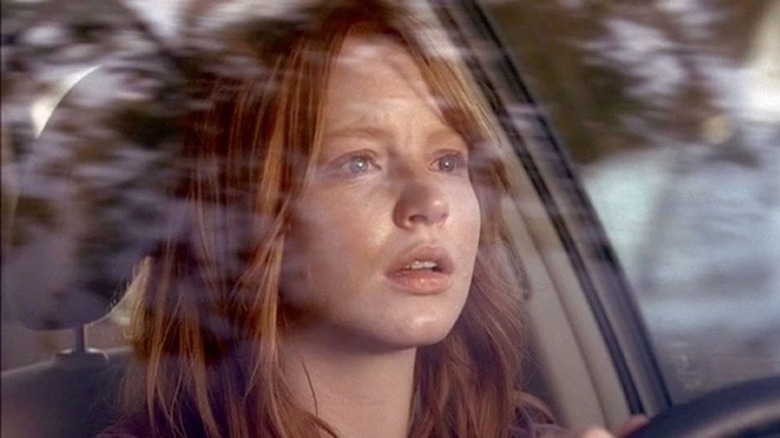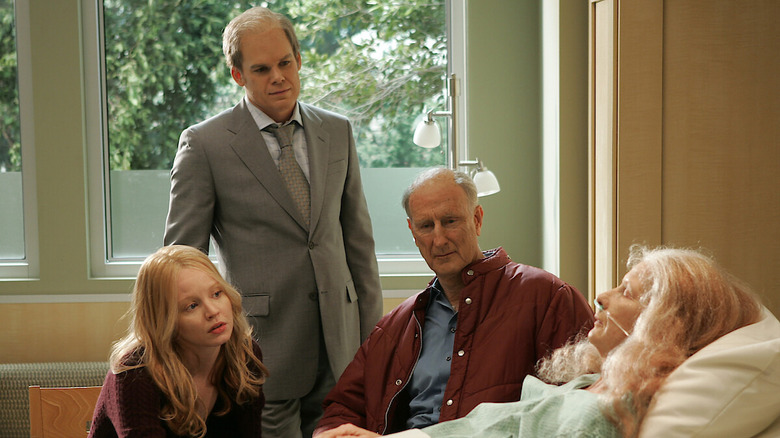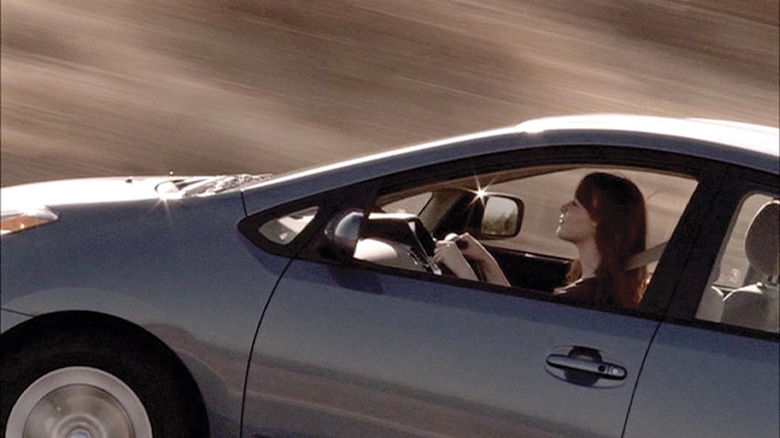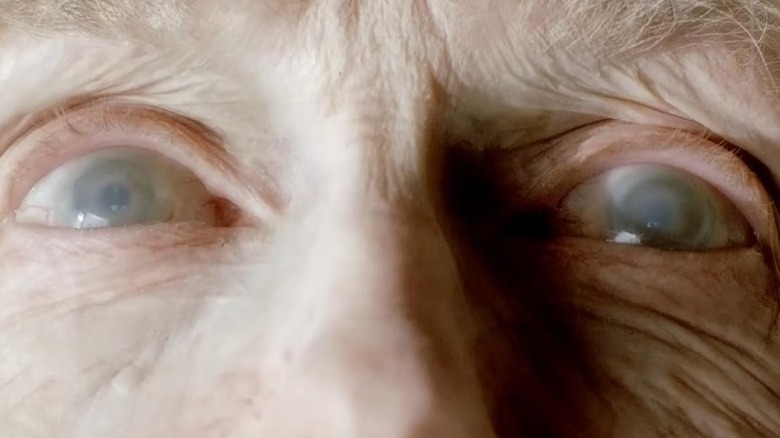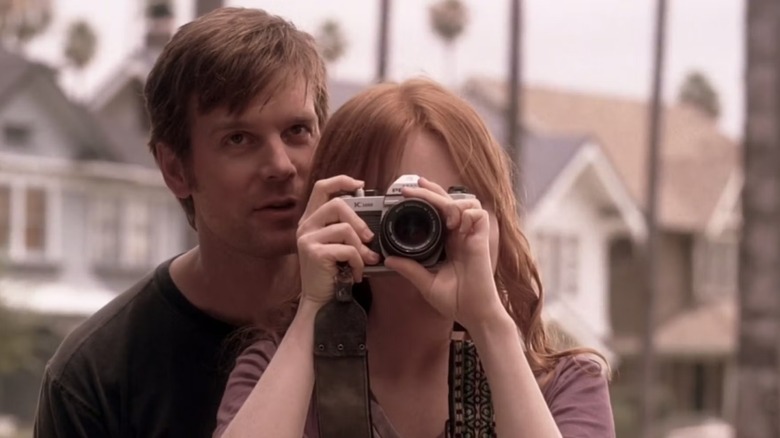Yes, Six Feet Under Really Does Have The Best Finale Of All-Time
When "Six Feet Under" came to Netflix in November 2023, I was eager to finally watch one of HBO's finest television shows. My father passed away in September, and while binging this series so soon after his death might seem like a masochistic endeavor, it was quite healing. One of the few things I knew about "Six Feet Under" was that many critics and audiences consider the final episode the greatest television ending of all time. As George R. R. Martin told Variety, "[T]hat last episode was far and away the best finale in the entire history of television, and I cannot imagine how anyone could possibly do better." Empire's review called it "almost unbearably moving and thrillingly executed."
I found it hard to believe that anything could top Don Draper finding Coke ad inspiration on a mountaintop or Walter White dying next to his baby blue. But after seeing the 12th episode of the fifth season, "Everyone's Waiting," I finally understood the cultural obsession with this ending, a seven-minute montage set to Sia's "Breathe Me." It begins with Claire saying goodbye to her family and driving to her new life in New York City, then jumps ahead to show the future lives — filled with babies, romance, friendship, pets, curiosity, joy, sadness, and laughter — and the eventual deaths of all the main characters. The way that Alan Ball gracefully constructs this montage is a master stroke of cinematic storytelling, bringing together music and images to express very emotional, ubiquitous truths.
The Six Feet Under finale brings us death on parade
We witness many deaths throughout "Six Feet Under," ranging from the humorous (a religious woman gets hit by a car after mistaking floating sex dolls for apocalyptic angels) to the heartwrenching (a woman gets decapitated the night she celebrates her long-awaited divorce). But seeing the main characters meet their inevitable demise in such rapid succession — characters that we've gotten to know and love for the past five seasons — feels particularly gut-wrenching.
Next year in 2025, Ruth will pass away surrounded by her family in the hospital. David will collapse at a family picnic in 2044. Other deaths are more tragic, such as Keith getting shot in a robbery or Rico dropping dead of a heart attack on vacation. In a brief moment of levity, we see Brenda literally being bored to death while listening to Billy (still!) yammering about Claire.
The juxtaposition of Claire's cloudy eyes as an elderly woman with the bright blues of her younger, determined self gives you goosebumps. We see a woman at two very significant points: the beginning of her adulthood and the end of her life. This haunting yet beautiful use of this match cut reminds us that our lives are over in the blink of an eye, so we have to make the most of it.
Television does not always follow characters to the end of their lives, leaving the audience free to imagine what happens to them in their future off-screen. When there is a death, it often feels like a neatly tied bow that wraps the narrative together. In "Six Feet Under," the sight of the Fishers' rather ordinary deaths cuts deeper than other well-crafted TV finales because it is not just the conclusion of a very specific story, it's the ending of all our stories.
Life is a highway as Claire (Lauren Ambrose) drives off into her future
There's something so peaceful about driving long distances while listening to music. Nowadays, we use our iPhones instead of mix CDs like the one Ted makes for Claire. The car is the perfect solitary space to zone out and contemplate your past, present, and future. Director Alan Ball's decision to intersperse the procession of deaths with Claire driving to New York is poetic and a clear metaphor for how life is a journey that constantly moves us forward — until one day it doesn't.
Using a helicopter and van with a crane-mounted camera, Alan Ball creates sweeping shots of Claire's Prius as it speeds across the desert (via Vulture). The tilted camera angles and propulsive movements make this moment in Claire's life feel epic and important, a milestone that will be remembered forever. The sight of Nate's running ghost in the rearview mirror, slowly getting further and further away until he is gone, is a moving symbol of Claire leaving her old life behind.
Alan Ball also toys with the concept of time by showing the desert view through Claire's dashboard moving in hyper-speed while she remains in normal time. This abstract effect is a striking reminder that life, even during its significant moments, can seem to pass by us in a blur. This dynamic framing and unique visual techniques give the final sequence an emotional grandeur that matches the broad themes of "Six Feet Under" as a whole: birth, death, and everything in between.
'Breathe Me' by Sia is the secret ingredient that makes the Six Feet Under finale so memorable
The choice of Sia's "Breathe Me" is the sequence's raison d'etre. The lyrics are simple, with Sia weakly confessing her depression in a gravelly voice. She implores the listener to "be her friend" and wrap her small, needy body in the warm embrace of companionship. Isn't that all any of us are looking for? "Six Feet Under" is ultimately about a group of broken people searching for a connection, someone they can "unfold" their true selves to, as Sia sings. Nate faces pressure to settle down with someone yet is never satisfied. Claire searches for a way to express her inner life through art and share it with others. David strives to build a traditional family with Keith. And Frances learns how to be an independent woman for the first time.
"Breathe Me" begins with gentle vocals and piano. When the drums join in, they create a driving rhythm that complements the shots of Claire moving across the desert. Lush strings take over the melody, followed by a brief pause where only a marimba is heard. Suddenly, the music bursts back to life with strings, drums, and piano crescendoing together. The music rises and swells like ocean tides, perfectly synchronized with the visuals of each character's death and Claire's Prius heading into the horizon. The use of "Breathe Me," a very intimate and melancholic ballad, tickles the emotional part of our brains — and our souls — that only music has the power to do.
'You can't take a picture of this, it's already gone' as Nate (Peter Krause) says in the Six Feet Under finale
The fact that photography was such a strong motif in "Six Feet Under" is no coincidence, as it relates to our innate desire to preserve and share memories. We all take photographs to remember significant moments because life is so fleeting. This brings to mind Nate's ghost saying, "You can't take a picture of this, it's already gone." Alan Ball uses the montage, one of the most powerful filmmaking agents for an emotional reaction, to elegantly stitch together the pivotal events in the Fisher's lives leading up to their deaths — birthday parties, weddings, and other gatherings with friends and family.
It's bittersweet to see snapshots of these events adorn Claire's walls before she passes away of old age. They are reminiscent of the collages we see displayed at funerals to honor the scope of our loved one's life. Although such moments are immortalized in frames, they will eventually be washed away by the sands of time, with future generations no longer recognizing them.
After watching the "Six Feet Under" finale for the first time, I couldn't stop crying and had an existential crisis about my time left on Earth. No other show has affected me so deeply, even my absolute favorites. Because "Six Feet Under" touches a nerve that no other series can. It's not exploring a distinct personal story, like an alcoholic ad man in the 1960s or a mafioso on Prozac, but rather the universal themes of life and death through the lens of an everyday family's domestic struggles. Ultimately, "Six Feet Under" gets to the heart of what it means to be human: the eventual loss of our family, friends, and selves.
